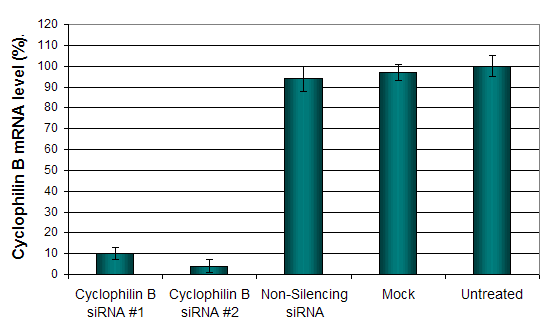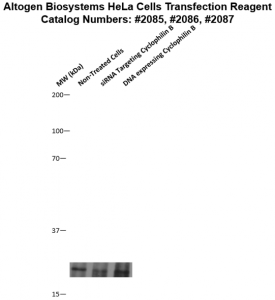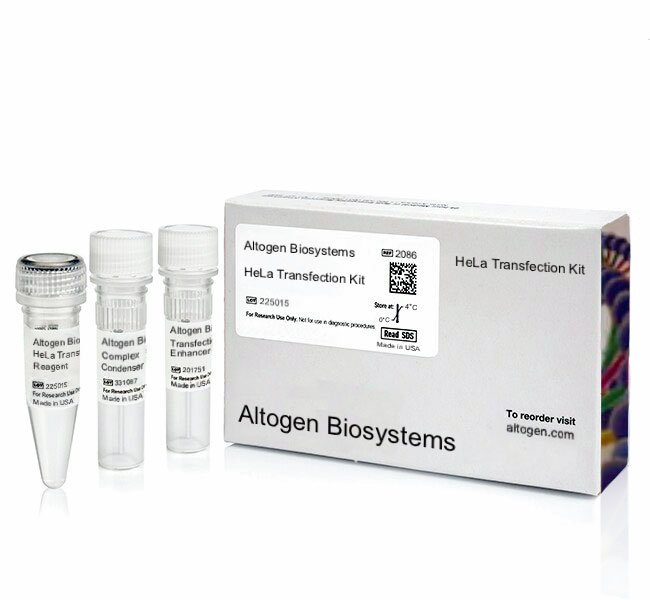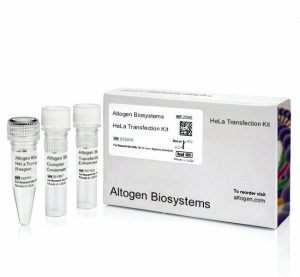Description
Purchase Orders: Click “Add to Cart” button to order, then email PO to orders@altogen.com.
Product Availability: In Stock.
Transfection Reagent for HeLa Cells (Cervix Adenocarcinoma Cells)
- Proprietary cationic lipids formulation
-
High transfection efficiency of small RNA (siRNA, shRNA, miRNA), mRNA, pDNA
-
Effective and robust intracellular delivery
-
Kit includes Transfection Enhancer reagent
-
A proven reagent for establishing stable cell lines
-
Optimized transfection protocols are adapted for use with both standard & reverse transfection methods
-
Download HeLa transfection protocol: [PDF]
- Download HeLa CRISPR/Cas9 transfection protocol: [PDF]
-
Download PowerPoint presentation for HeLa cells transfection kit: [PPT]
- UPC/GTIN/EAN: 860002089771
-
Brand: ALTOGEN®, developed and manufactured by Altogen Biosystems
Transfection Efficiency:
Reagent exhibits at least 90% transfection efficiency of siRNA delivery.
Product Description:
High efficiency transfection reagent for HeLa cell line, a human cervical cancer cells. Transfection reagent supplemented by complex condenser and transfection enhancer ensures high efficiency in delivering cargo biomolecules into these cells.
Transfection Protocol and SDS:
Download Altogen Biosystems HeLa Transfection Protocol: [PDF]
Download SDS: [PDF]
HeLa Cell Line:
The HeLa cell line was established from cervical cancer cells, contributing to significant medical breakthroughs, including the development of polio vaccine. HeLa is a human cell line that was first isolated in 1951 from a cervical cancer biopsy taken from a woman named Henrietta Lacks. The HeLa cell line is one of the oldest and most widely used human cell lines in biomedical research. It has been used to study a wide range of biological processes, including cell division, cancer biology, virology, and drug discovery. In addition to being the first immortal human cell with the ability to survive indefinitely in vitro, the HeLa cell line proliferates rapidly due to an active telomerase during cell division, resulting in the prevention of aging and cell death. The HeLa cell line was established using cervical cancer cells taken from Henrietta Lacks, a 31-year-old patient in 1951 who eventually died of her cancer later that year. The cells were derived from a tissue sample excised from the adenocarcinoma. The HeLa cell line has a modal chromosome number of 82 as well as four copies of chromosome 12 and three copies of chromosomes 6, 8, and 17. HeLa tests positive for keratin and lysophosphatidylcholine. Hela cells are also known to contain human papillomavirus 18 sequences. There are now many strains of HeLa cells, but all are descended from the same tumor cells removed from Lacks. Also, HeLa cells were used by Jonas Salk to test the first polio vaccine in the 1950’s. HeLa cells are highly proliferative and can divide rapidly in culture, making them an ideal tool for studying cell division and the effects of drugs on cell growth. They are also commonly used to study cancer biology because they are derived from a cancerous tissue and exhibit many of the characteristics of cancer cells, such as uncontrolled growth and division. They have also been used in AIDS research, effects of radiation and toxic substances and gene mapping. Altogen Biosystems offers the HeLa transfection reagent kit for the HeLa cervical cancer cell line, an invaluable tool in conducting a broad array of specialized biomedical applications.
Mutations:
| GPR97 | 222487 | 37 | 16 | 57713216 | 57713216 | Missense_Mutation | SNP | C | T |
| EGFLAM | 133584 | 37 | 5 | 38352349 | 38352349 | Nonsense_Mutation | SNP | C | A |
| RECK | 8434 | 37 | 9 | 36121662 | 36121662 | Missense_Mutation | SNP | G | T |
| RYR2 | 6262 | 37 | 1 | 237947546 | 237947546 | Silent | SNP | C | T |
| ILDR2 | 387597 | 37 | 1 | 166888604 | 166888604 | Silent | SNP | G | A |
| C1orf112 | 55732 | 37 | 1 | 169811639 | 169811639 | Missense_Mutation | SNP | G | C |
| DNAAF1 | 123872 | 37 | 16 | 84183927 | 84183927 | Missense_Mutation | SNP | C | T |
| SV2C | 22987 | 37 | 5 | 75428097 | 75428097 | Silent | SNP | C | T |
| WDR91 | 29062 | 37 | 7 | 134878103 | 134878103 | Silent | SNP | C | T |
| OR1K1 | 392392 | 37 | 9 | 125562682 | 125562682 | Missense_Mutation | SNP | C | T |
| UNC5D | 137970 | 37 | 8 | 35579744 | 35579744 | Silent | SNP | C | T |
Data:

Figure 1. Cyclophilin B silencing efficiency was determined by qRT-PCR in HeLa cells transfected by Cyclophilin B siRNA or non-silencing siRNA control following the recommended transfection protocol. Cyclophilin mRNA expression levels were measured 48 hours post-transfection. 18S rRNA levels were used to normalize the Cyclophilin B data. Values are normalized to untreated sample. Data are presented as means ± SD (n=3).

Figure 2. Protein expression of Cyclophilin B in HeLa cells. DNA plasmid expressing Cyclophilin B or siRNA targeting Cyclophilin B were transfected into HeLa cells following Altogen Biosystems transfection protocol. At 72 hours post-transfection the cells were analyzed by Western Blot for protein expression levels (normalized by total protein, 10 µg of total protein loaded per each well). Untreated cells used as a negative control.
Selected in vivo transfection product citations (ALTOGEN® IN VIVO Transfection Kits used in the following publications):
- Nature. 2008 454(7203):523-7. Innate immunity induced by composition-dependent RIG-I …Saito et al [PDF]
- Am J Pathology. 2010 177(4):1870-80. Role of ocular complement factor H in a murine model … Lyzogubov et al [PDF]
- Nature Biotechnology. 2011 29(4):341-5. Delivery of siRNA to the mouse brain by … Alvarez-Erviti et al [PDF]
- Cancer Research. 2011 71(15):5144-53. Inhibition of miR-193a expression by… Iliopoulos et al [PDF]
- RNA. 2010 16(11):2108-19. RNase L releases a small RNA from HCV RNA that refolds … Malathi et al [PDF]
- Diabetologia. 2012 55(7):2069-79. The p47phox- and NADPH oxidase organiser 1 … Youn et al [PDF]
- British Journal of Cancer. 2012 107(3):516-26. TIGAR induces p53-mediated cell-cycle … Madan et al [PDF]
- Hypertension. 2014 63(2):353-61. Tissue transglutaminase contributes to … Liu et al [PDF]
- Circulation Research. 2010 15;107(8). Kruppel-like factor-4 transcriptionally regulates … Cowan et al [PDF]
- Hypertension. 2012 59(1):158-66. Role of uncoupled endothelial nitric oxide synthase … Gao et al [PDF]
- Jounal of Biological Chemistry. 2012 287(4):2907. Chaperoning of mutant p53 protein … Gogna et al [PDF]
- PLoS Pathogens. 2012 8(8) Uridine composition of the poly-U/UC tract of HCV RNA … Schnell et al [PDF]
- J Proteome Res. 2012(11) Retinal proteome analysis in a mouse model of oxygen-induced … Kim et al [PDF]
- J Transl Med. 2010 15;8:133. Prevention of hyperglycemia-induced myocardial apoptosis … Zhang et al [PDF]
- Mol Cell Biol. 2013 33(7). SCO2 induces p53-mediated apoptosis by Thr845 phosphorylation … Madan et al [PDF]
- Hypertension. 2015 65(2):430-9. Neurokinin 3 receptor and phosphocholine transferase… Parchim et al [PDF]
- Gastroenterology. 2011 141(2) Differential type I interferon-mediated autophagic trafficking … Desai et al [PDF]
- PLoS Pathog. 2014 10(10) Exosomes from hepatitis C infected patients transmit HCV … Bukong et al [PDF]
Altogen Biosystems manufacturers over 100 pre-optimized in vitro transfection kits for cancer cell lines and primary cells, elecroporation products, and tissue-targeted in vivo delivery reagents for life science research. Advanced formulation of reagents and optimized transfection protocols provide efficient intracellular delivery of protein, DNA, mRNA, shRNA and siRNA molecules. Read more about transfection technology at Altogen’s Transfection Resource. Altogen Labs provides safety and efficacy preclinical research services. GLP-compliant studies for IND applications, and drug development, including over 90 in-house validated xenograft models, safety toxicology, etc (visit AltogenLabs.com).
Volume Options:
- 0.5 ml (Catalog #2085)
- 1.5 ml (Catalog #2086)
- 1.5 ml CRISPR (Catalog #2150)
- 8.0 ml (Catalog #2087)
Purchase Orders: Click “Add to Cart” button to order, then email PO to orders@altogen.com.
Product Availability: In Stock.






